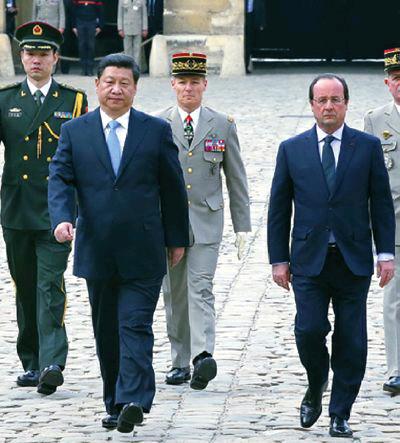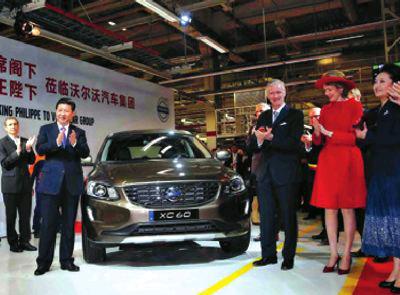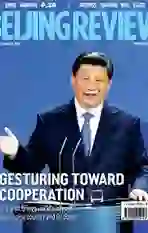A SEAMlESS JOINN
2014-05-08ByDingying
By+Ding+ying
two major powers, two major mar- kets and two major civilizations. China and the European Union (EU) represent the worlds largest developing country and the biggest union of developed economies, respectively. A common need for development has brought them closer together.
From March 22 to April 1, Chinese President Xi Jinping conducted his first European tour since taking office in March 2013, sealing cooperative agreements between China and Europe both strategically and practically.
Cooperation blueprint
As Chinese Foreign Minister Wang yi said on March 8 when introducing the countrys foreign policies and relations, Europe occupies a place of priority in Chinas 2014 diplomatic schedule. Xis tour covered state visits to four EU member states and a visit to the EU headquarters in Brussels. On April 2, when the Chinese president ended his tour, China issued its second policy paper on the EU, clarifying the China-EU relationship and its role in the world. The countrys first policy paper on the EU was released 11 years ago.
Xis visit aimed to promote mutual political and economic trust between China and Europe, and expand bilateral cooperation in new areas as well as in traditional fields including trade. In addition, the trip plotted out a clearer cooperation strategy between them, so as to put their allround strategic partnership into practice, said Feng Zhongping, vice president of the China Institutes of Contemporary International Relations.
The four countries Xi visited were thoughtfully selected. Germany and the Netherlands are Chinas biggest and second biggest trade partners in the EU; France was the first major Western country to establish a diplomatic relationship with China at the ambassadorial level; and Belgium is where the EU is headquartered.
A host of new “firsts” were made during Xis European tour. It was the first time a Chinese president has visited the Netherlands; the first state visit Chinas president had conducted to Germany in the past eight years; the first state visit Chinas president had made to Belgium during the past 27 years; and the first time a Chinese head of state has visited the EU headquarters. China and the EU issued a joint statement on March 31, defining Xis visit to the EU headquarters as “a historic landmark in China-EU relations.” Chinas relationships with the four countries were also promoted during Xis visit.endprint
The China-EU relationship has become increasingly close in recent years. Last year, Chinese Premier Li Keqiang paid two visits to Europe. And a series of European leaders—French President Francois Hollande, Prime Minister of the Netherlands Mark Rutte and British Prime Minister David Cameron—successively arrived in China to meet Chinas new government formed in March. On November 26, 2013, a significant cooperative document, titled China-EU 2020 Strategic Agenda for Cooperation, was released, posing 93 initiatives on peace and security, prosperity, sustainable development and cultural exchanges.
Chinas diplomatic strategy has become more active due to its growing strength and increasingly mature diplomatic wisdom. Greater relations with Europe will be the main diplomatic direction of China, said Ruan Zongze, vice President of the China Institute of International Studies (CIIS), pointing out that Xis visit signaled the growing trend. “Chinas major-power diplomacy focuses not only on the United States and Russia, but also on Europe,” Ruan said.
China and Europe share similar targets of development and global functions, which provides the motivation for their closer bond.
“There is a historic opportunity to deepen the relationship between China and Europe,”said Cui Hongjian, a researcher on European studies with the CIIS. During Xis trip, China and European countries expressed their support for each others reform and development plans. As China carries out a new round of reform and expands overseas investment, European countries are struggling to recover from the financial crisis, which presents an opportunity for high coherence, said Cui. The joint statement issued by China and the EU confirmed they would deepen their relationship based on equality, mutual trust and mutual respect, devoting themselves to building partnerships of peace, reform, growth and civilization.
According to the joint statement, China and the EU reached consensus about their roles in the world on a policy level, summarized as protecting world peace and stability, multipolarization, free trade, finding political and diplomatic solutions to disputes, and diversity of civilization.
In the joint statement, the two sides reiterated their commitment to further advancing China-EU relations in next 10 years to benefit Chinese and European peoples and promote world peace and prosperity. Moreover, China and the EU agreed to upgrade their defense security dialogue and promote legislation cooperation, reflecting the all-round cooperation strategy.endprint

Business opportunities
The solid strategic basis will serve to support cooperation in various aspects between China and Europe, particularly in the trade, economic and investment areas. Mutually beneficial cooperation will create a tremendous boon for both China and Europe.
“The China-EU relationship now stands at a new starting line, as they face a significant opportunity to deepen cooperation,” said Ruan. As China carries out its 12th Five-year Plan(2011-15), Europe is advancing its Europe 2020 Strategy, which means their development plans are at an abutting joint, he added. “Their interests have already deeply intertwined.”
Economic cooperation has been the adhesive between China and Europe. The EU has been Chinas top trade partner for the past 10 years, while China is the EUs second biggest trade partner. China and the EU are each others top exporter. Their trade volume in 2013 was $559.1 billion, according to official Chinese statistics. In spite of the sluggish world economy, their daily trade volume reached $1.5 billion.
Trade and economic cooperation between the two sides has been complementary. China has provided industrial and consumer products to Europe, while the EU has sold high value-added products to China. Even in traditional aspects, there is still huge room to boost trade between the two. Trade between China and 16 Central and East European nations barely reaches one 10th of the total trade volume between China and the EU. Additionally, bilateral service trade is only about one 10th of the China-EU trade.
Mutual investment has been on the rise. In 2013, the EUs direct investment to China was $6.52 billion, increasing 21.9 percent from the year before. Chinas direct investment to the EU was $3.62 billion, seeing a 6.2-percent growth. But this figure doesnt match the high economic cooperation level between China and the EU. According to statistics from the EU, Chinas investment to the EU was only 1 percent of the total foreign investment that had flown into the latter, of which U.S. investment accounted for 21 percent. EU investment to China, meanwhile, was only 2 to 4 percent of its overall overseas investment, of which 30 percent went to the United States.
The bottleneck is expected to be passed now. During Xis visit, China and the four EU members signed over 120 cooperative agreements, valuing more than $70 billion. According to the joint statement that the two sides issued on March 31, China and the EU will fully implement the China-EU 2020 Strategic Agenda for Cooperation and launch the negotiation process of the China-EU Investment Agreement that covers investment protection and market access. On China-EU trade and investment relations, the two sides underlined the necessity of coordinating their policies to ensure strong, sustainable and balanced growth and to foster financial stability.endprint
Such a pact “will convey both sides joint commitment toward stronger cooperation as well as their willingness to envisage broader ambitions,” the statement said. It also listed “a deep and comprehensive” free trade agreement as a longer-term perspective.
“The cooperative prospects before China and the EU are very bright,” said Qu Xing, President of the CIIS. He noted many linking points between China and Europe in their development targets, such as green energy, environmental protection, poverty reduction, scientific research, urbanization, cultural communication, energy conservation and emission reduction.
In past years, China has actively assisted Europe in surviving the financial crisis in different channels including purchasing national bonds—efforts that are greatly appreciated by the EU. Moreover, China and the EU are exploring new ways of cooperation spanning the Eurasian Continent, Qu added. For example, with an eye to lifting transport relations, the two sides decided to develop synergies between Chinas Silk Road Economic Belt initiative and EU policies, and to jointly explore common cooperation initiatives along the belt.
China and the EU have been adjusting the definition of their relationship, Wang yiwei, a professor with the Renmin University of China said. China would primarily consider the EU as a partner of peace in addition to a major trade partner, mirroring Chinas new expectation toward the EU, while the EU chooses to be a“superpartner” rather than a “superpower,”Wang explained. He added that the EU targets itself as a player between China and the United States, no longer at one end of a multi-polar world because of its debt crisis and the U.S. AsiaPacific policy.
Communication between China and Europe can be traced back to centuries ago. Napoleon Bonaparte metaphorically referred to China as a sleeping lion in the early 19th century, when China was too weak and poor to be a world player. During Xis tour, China confidently declared its return to the global arena. The Chinese president stated Chinas opinions on the world in four speeches in Europe, promising China will continue to contribute to world peace and prosperity.
“China, the sleeping lion, has woken up,”said Xi in a speech delivered in France. “But it is peaceful, pleasant and civilized.” When meeting with EU leaders in November 2013, Xi defined China and the EU as two major powers protecting world peace, two major markets promoting common development, and two major civilizations pushing forward human progress. Now, the biggest developing country and the biggest union of developed countries in the world have set their seamless joint.endprint
